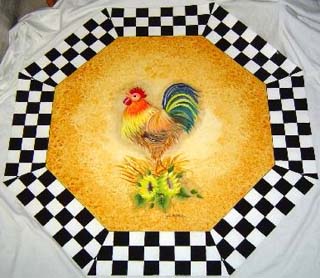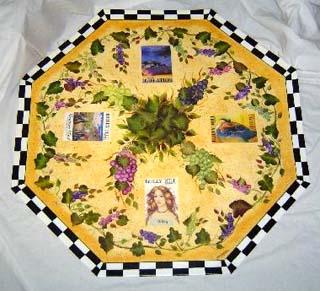
Painted floorcloths becomes avocation The first time Gloria Vignola saw a floorcloth it was on a television program and even through that venue she knew it was poorly made. Her getting involved in floorcloth making was as simple as "I knew I could do better than that." Vignola, owner of Gloria's Creative Painting in Spencerport, said later, she was in need of some sort of floor covering for her kitchen and that sparked her interest to make her own floorcloth. "I was surprised how durable they were," she said, after researching the hows and whys of making a floorcloth. "What really got me interested was the practicality and versatility of the floorcloth. They beautify a room and keep hardwood, tile or linoleum floors clean." While Vignola has been handcrafting floorcloths for about 15 years, their history dates back several hundred years. In Europe and early American times, they were originally designed by the Quakers to be alternative, affordable coverings for their floors. Original designs were simple stencil paintings. Today's floorcloths have emerged as a creative combination of practicality and artistic expression. Floorcloths are essentially fine art canvas rugs: They are constructed from heavy weight cotton canvas, hand painted, hand finished and then sealed on both sides for protection and long-lasting wear. "I get my designs from several sources such as new trends, magazines, books, the internet, " she said. "Some of them have special meaning - the rooster is an example - it reminds me of a trip to the south of France, country surroundings and I love the many colors in the rooster's feathers." The floorcloth with the faces are from wine labels from the Rochester region, which were applied to the cloth in a decoupage technique. The grapes and vines were drawn freehand by Vignola then handpainted. It takes Vignola about two to three weeks to complete one floorcloth. "They are very labor intensive." Vignola prides herself on the craftsmanship and time she puts into making her floorcloths. "The cotton canvas and materials are of the highest quality," she said. "The canvas has to be primed three times on each side and dried thoroughly between each priming." Following the painting of the design, the floorcloth is then coated with five coats of sealer and one coat of wax. On the reverse side of the cloth, a heavy coat of non skid latex is applied, she said. "You can literally walk on the floorcloths over and over again," she said. "They are made to be stepped on but are for use on bare floors only." Clean up is simple - warm water and mild soap. The average price of a 21 inch floorcloth is $80. Her floorcloths will be featured at a Holiday Bazaar on Friday, November 18 from 5 to 9 p.m.; Saturday, November 19 from 9:30 a.m. to 5 p.m. and Sunday, November 20 from 11 a.m. to 4 p.m. at the Museum and Science Center, 657 East Avenue, Rochester. About this occasional feature: If you, or someone you know, has an interesting hobby or vocation, contact Robbi Hess at 352-3411 ext. 129. November 20, 2005 |


